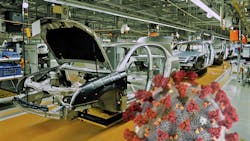Translate Lessons from the Pandemic into Growth Strategies
This article appeared in Machine Design and has been published here with permission.
What you'll learn:
- Stefan Issing, global automotive industry director and senior solution architect, IFS, discusses business and operational impacts stemming from the pandemic.
- How will cars be sold in the future? (Hint: at your fingertips.)
- Enterprise resource planning is undergoing a transformation.
When the last Chevy Cruze rolled off a General Motors assembly line in Lordstown, Ohio back in March, the assembly plant’s closure had little to do with the pandemic. The move was instead indicative of changes already underway in the auto industry.
Yet, by July, when GM’s U.S. second quarter vehicle sales declined about 34% compared to a year ago, the automaker reported the results were impacted by reduced demand due to the COVID-19 pandemic, as well as tight dealer inventories resulting from production shutdowns earlier in the year.
Similar reports of disruption would trigger temporary closures across North America. From Ford, Fiat Chrysler and Honda to Toyota and Nissan, automakers moved to idle their factories, forcing hundreds of parts and component producers to come to a temporary standstill.
Unplanned shutdowns raised unique challenges, the effects of which have spurred the need for contingency plans that enable operational effectiveness, argued Stefan Issing, global automotive industry director and senior solution architect, IFS, a global enterprise applications company.
Shipment or supply chain delays during lockdowns rate high on the impact leaderboard, according to Issing. “Whether you talk about Asian suppliers delivering to European automakers or to North American automakers, components were not being delivered,” he said. “The supply chain was disrupted badly in the beginning, and when they started up again, OEMs closed their plants, causing a wave effect that impacted different regions of the world.”
Disruptions can be a baseline for risk mitigation and future planning. One business practice that Issing said gained ground during the pandemic is Demand Driven Materials Requirement Planning, a lean planning method that can help manufacturers offset spikes in demand. In their quest to return to productivity, manufacturers can make better decisions with the use of management tools, particularly when complemented by reliable ERP solutions, he explained.
In the following abridged version of an interview with Machine Design, Issing reflected on lessons learned during the pandemic and considered industry shifts in its aftermath.
The impact of the pandemic shifted the collective frame of mind. As we close out the year and plan ahead, which events might be relegated to the past and what changes will persist?
One [development] could be how cars will be sold in the future. I think Tesla was the first mover in selling cars via the Web. So, you can buy a car on an online shop, like Amazon, and you’d go to a car dealership just to have a test drive. I’m not sure if dealerships will need big rooms just to have 100 cars to touch in different colors. Why not sell it via the internet? It works. I think many other functionalities, such as augmented reality and 3D, allow you to put the configured car in front of your house just to see if the color fits. I think the trend is that much of the personal contact and how you buy your car will be shifted to the Web.
Overall, when we talk about supply chain and what will change, second sourcing would be one of the biggest trends. So, moving back from globalization a little bit and reaching more to regional markets. Also, if the parts might be more expensive, I think people will understand why it is more expensive. This trend to get cheaper, cheaper, cheaper and far away will be completely switched.
That is what we’ve already realized; we have a big Canadian customer, Linamar, in our region. And they just started to be a secondary supply source in Germany for BMW. They could produce anywhere, but this BMW is assembled here in Germany. So, the suppliers are coming closer to the OEMs.
We’re also witnessing a shift in business models—not necessarily started as a result of the pandemic, although we’ve observed an uptick in distributed manufacturing. When automotive plants went dark earlier this year, some switched to producing personal protective equipment (PPE). What’s the one big change that stems from the pandemic?
Before the pandemic, [the] automotive business was already undergoing change, and I think this change wasn’t finished yet. When you look at the production of a traditional car with a traditional engine and compare it to electric vehicles powered with batteries, the way they are produced is completely different. In the past, the step when you when you put the engine into the chassis was the most important thing.
Producing an EV is completely different. The complexity is lower, funny enough, because the number of parts that are used in the EV are only a third of that of a traditional car. Quite impressive. In the past it was about around 35,000, and now we are down to 10,000 to 15,000 when we talk about an EV. So that is a change that also needs a change in production.
The way that we used to produce on the traditional Henry Ford assembly line is not common anymore. We now have so-called assembly plant islands, where the car is driving automatically through the factory. And in the case where the customer didn’t configure heated seats, the vehicle would just skip the assembly island for this type of seats and move on to the next.
Automakers are highly automated in their operations, but I think we still need to workers to assemble a car. [Factories] will not be completely automated by robots, although the degree of automation will increase for sure. But I think we have to finish what we started before the pandemic when big change was already on its way.
Let’s segue and talk about how enterprise resource planning (ERP) tools fit into the picture. How is the role of ERP systems being transformed?
In North America it’s completely different when you look at where our customer base is. Companies go to the cloud. In our region in Europe it’s still a strange mindset for companies to go to the cloud. I’m not sure why that it is. We have many customers in the cloud in North America and we have only a few in Germany. The new IT directors are younger, they are familiar with it, they are used to it.
I had a discussion last week with an analyst from Gartner, and we talked about these integrated solutions and best of breed. I think there will always be an ERP system as a core because you need financial data; you need to supply master data, path data and so on. Where the data comes from has completely changed and the evolved architecture is built for both cloud and on-premises. But the need for supporting ERP software will remain essential for the future.
What are the concerns around data security in the cloud?
That is always a discussion when I talk to my customers. I always say, I don’t think that you have anybody in your team who can cover what Microsoft is covering. If our partner, Microsoft—we use the Azure Cloud—is not a secure place to store your data, you don’t have a secure place.
We had a prospect in Switzerland who was blackmailed. All of their information around construction engineering was hijacked and stolen. When they refused to pay the ransom, the hackers started to publish engineering information on Twitter. They had an on-premise solution with a firewall and it shows what hackers can do to a big company. But you cannot be as secure as a Microsoft Cloud could be.
There are other concerns when we talk about the cloud: Where’s my data, who can have access to the data, is that data private? And that is another discussion, because when you talk about the hosted solution you see your data somewhere within your system, but you don’t know which machine it relates to or you cannot get your data out.
About the Author

Rehana Begg
Editor-in-Chief, Machine Design
As Machine Design’s content lead, Rehana Begg is tasked with elevating the voice of the design and multi-disciplinary engineer in the face of digital transformation and engineering innovation. Begg has more than 24 years of editorial experience and has spent the past decade in the trenches of industrial manufacturing, focusing on new technologies, manufacturing innovation and business.
Her B2B career has taken her from corporate boardrooms to plant floors and underground mining stopes, covering everything from automation & IIoT, robotics, mechanical design and additive manufacturing to plant operations, maintenance, reliability and continuous improvement.
Begg holds an MBA, a Master of Journalism degree, and a BA (Hons.) in Political Science. She is committed to lifelong learning and feeds her passion for innovation in publishing, transparent science and clear communication by attending relevant conferences and seminars/workshops.

